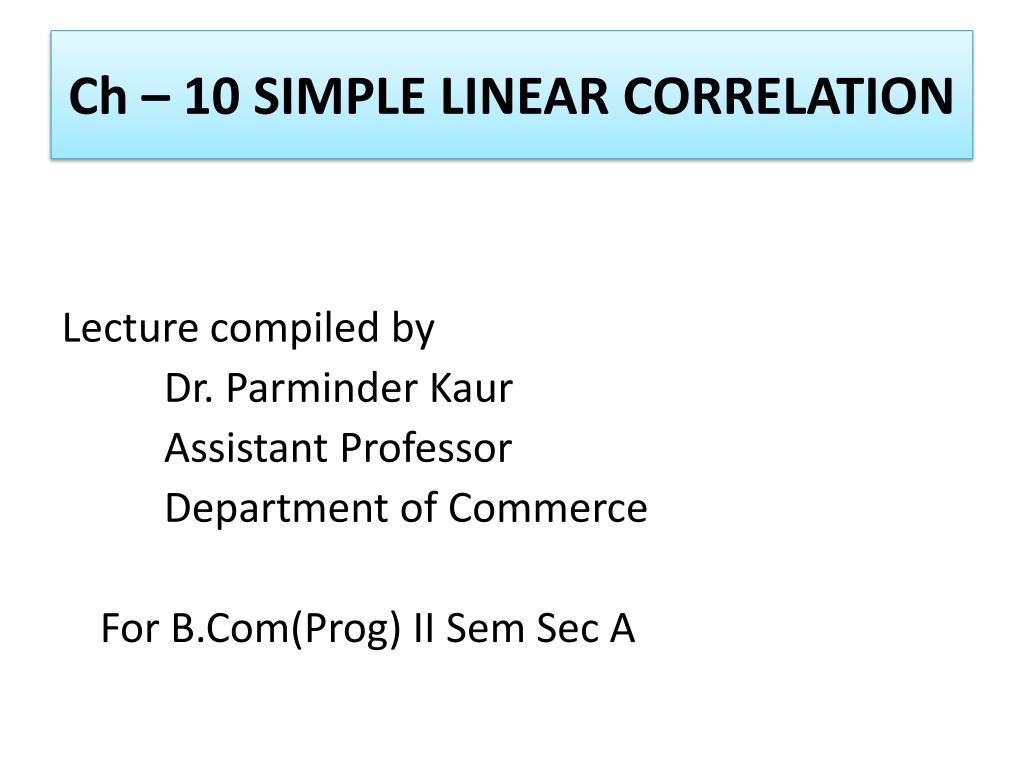Understanding Simple Linear Correlation in Commerce: Lecture Compilation by Dr. Parminder Kaur
Correlation analysis is essential in understanding the co-variation between two or more variables. This lecture compiled by Dr. Parminder Kaur, an Assistant Professor in the Department of Commerce, delves into the definition of correlation, types of correlation such as positive/negative, simple/partial/multiple, and linear/non-linear correlations. It explores methods of studying correlation including scatter diagram and Karl Pearson's Coefficient of Correlation. Gain insights into how variables relate and influence each other in the realm of commerce.
Download Presentation

Please find below an Image/Link to download the presentation.
The content on the website is provided AS IS for your information and personal use only. It may not be sold, licensed, or shared on other websites without obtaining consent from the author. Download presentation by click this link. If you encounter any issues during the download, it is possible that the publisher has removed the file from their server.
E N D
Presentation Transcript
Ch 10 SIMPLE LINEAR CORRELATION Lecture compiled by Dr. Parminder Kaur Assistant Professor Department of Commerce For B.Com(Prog) II Sem Sec A
SIMPLE LINEAR CORRELATION DEFINITION OF CORRELATION If two or more quantities vary in sympathy so that movements in accompanied by corresponding movements in other(s) then they are said to be correlated. Or Correlation is an analysis of co-variation between two or more variables. one tend to be
TYPES OF CORRELATION The correlation: Positive and Negative Correlation Simple, Partial and Multiple Correlation Linear and Non-linear Correlation following are different types of
Positive and Negative Correlation The correlation between two variables is said to be positive or direct if an increase (or a decrease) in one variable corresponds to an increase (or a decrease) in the other. The correlation between two variables is said to be negative or inverse if an increase (or a decrease) corresponds to a decrease (or an increase) in the other.
Simple, Partial and Multiple Correlation Simple Correlation: It involves the study of only two variables. For example, when we study the correlation between the price and demand of a product, it is a problem of simple correlation. Partial Correlation: It involves the study of three or more variables, but considers only two variables to be influencing each other. For example, if we consider three variables, namely yield of wheat, amount of rainfall and amount of fertilizers and limit our correlation analysis to yield and rainfall, with the effect of fertilizers removed, it becomes a problem relating to partial correlation only. Multiple Correlation: It involves the study of three or more variables simultaneously. For example, if we study the relationship between the yield of wheat per acre and both amount of rainfall and the amount of fertilizers used, it becomes a problem relating to multiple correlation.
Linear and Non-linear Correlation Linear Correlation: The correlation between two variables is said to be linear if the amount of change in one variable tends to bear a constant ratio to the amount of change in other variable. Non-linear (or Curvilinear): The correlation between two variables is said to be non-linear or curvilinear if the amount of change in one variable does not bear a constant ratio to the amount of change in other variable.
METHODS OF STUDYING CORRELATION Scatter Diagram Method Karl Pearson s Coefficient of Correlation, and Rank Correlation Method
Scatter Diagram Method A scatter diagram of the data helps in having a visual idea about the nature of association between two variables. If the points cluster along a straight line, the association between two variables is linear. Further, if the points cluster along a curve, the corresponding association is non-linear or curvilinear. Finally, if the points neither cluster along a straight line nor along a curve, there is absence of any association between the variables.
Covariance The covariance between X and Y, is denoted by Cov (X, Y)
Thankyou Lecture sourced from Book Business Mathematics and Statistics by R. S. Bhardwaj Book Business Mathematics and Statistics by Dr. J. K. Thukral























